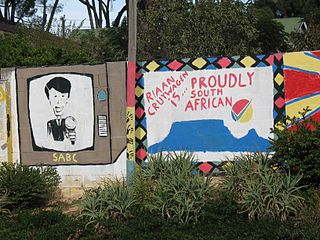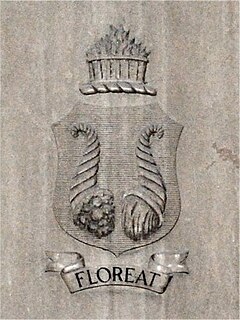 W
WThe culture of South Africa is known for its ethnic and cultural diversity. Among black South Africans, a substantial number of rural inhabitants lead largely impoverished lives. It is among these people, however, that cultural traditions survive most strongly; as South Africans have become increasingly urbanized and Westernised, aspects of traditional culture have declined. Urban South Africans usually speak English or Afrikaans in addition to their native language. There are smaller but still significant groups of speakers of Khoisan languages, not included in the eleven official languages, but are one of the eight other officially recognised languages. There are small groups of speakers of endangered languages, most of which are from the Khoisan family, that receive no official status; however, some groups within South Africa are attempting to promote their use and revival.
 W
WAdamastor is a mythological character created by the Portuguese poet Luís de Camões in his epic poem Os Lusíadas, as a personification of the Cape of Good Hope, symbolizing the dangers of the sea and the formidable forces of nature challenged and ultimately overcome by the Portuguese during the Discovery Age. Adamastor manifests itself out of a storm.
 W
WAfrikaans folklore is the body of traditional literature, music, dance and customs present in Afrikaans-speaking cultures.
 W
WThe coat of arms of the Western Cape is the official heraldic symbol of the Western Cape province of the Republic of South Africa. It has been in use since 1998.
 W
WThe Dagga Couple or DC is a pro-cannabis lobbyist organisation from South Africa founded by Julian Stobbs and Myrtle Clarke after the two were arrested for the possession and dealing in the substance in 2010. Rather than plead guilty, the couple decided instead to sue seven sectors of government that maintained and enforced the policy of cannabis prohibition in the country resulting in what has been described locally as the Trial of the Plant in 2017. Stobbs was fatally shot during an armed robbery at his home in Sunrella, Gauteng on 3 July 2020. Clarke, who was with him at the time of the incident escaped unharmed.
 W
WThe Department of Arts and Culture was until 2019 a department of the South African government. It was responsible for promoting, supporting, developing and protecting the arts, culture and heritage of South Africa. The heritage sites, museums and monuments of the country also resided under this ministry. The political head of the department was the Minister of Arts and Culture. In June 2019 the department was merged with Sport and Recreation South Africa to form a new Department of Sports, Arts and Culture.
 W
WDistrict Six Museum is a museum in the former inner-city residential area and, District Six, in Cape Town, South Africa in an old Methodist church.
 W
WHeritage Day is a South African public holiday celebrated on 24 September. On this day, South Africans are encouraged to celebrate their culture and the diversity of their beliefs and traditions, in the wider context of a nation that belongs to all its people.
 W
WVarious cultures throughout Africa utilize insects for many things and have developed unique interactions with insects: as food sources, for sale or trade in markets, or for use in traditional practices and rituals, as ethnomedicine or as part of their traditional ecological knowledge. As food, also known as entomophagy, a variety of insects are collected as part of a protein rich source of nutrition for marginal communities. Entomophagy had been part of traditional culture throughout Africa, though this activity has been diminishing gradually with the influx of Western culture and market economies. Often the collection of insects for food has been the activity of children, both male and female.
 W
WLitema is a form of Sesotho mural art composed of decorative and symbolic geometric patterns, commonly associated with Sesotho tradition today practised in Lesotho and neighbouring areas of South Africa. Basotho women generate litema on the outer walls and inside of homesteads by means of engraving, painting, relief mouldings and/or mosaic. Typically the geometric patterns are combed or scratched into the wet top layer of fresh clay and dung plaster of the wall, and later painted with earth ochers or, in contemporary times, manufactured paint. Patterns most often mimic ploughed fields through a combed texture, or the patterns refer to plant life, and more occasionally to other aspects of the natural world, such as referring to clan totem animal. Litema are transient; they may desiccate and crumble or be washed away by heavy rain. It is common for women of an entire village to apply litema on such special occasions as a wedding or a religious ceremony.
 W
WA makarapa is a hand-cut and hand-painted hard hat worn by sports fans. They belong to the typical South African football fan's supporters gear, and are increasingly popular with fans of other sports. Sport fans spend hours on sculpting and painting their makarapa in the colours and emblem of their clubs or country. Besides the makarapa, fans also wear giant glasses or have shields with team slogans and logos. With the 2010 FIFA World Cup, the international profile and availability of the makarapa has increased greatly.
 W
WThe South African music scene includes both popular (jive) and folk forms like Zulu isicathamiya singing and harmonic mbaqanga. South Africa has a global music industry.
 W
WThe National Library of South Africa is the agency of the government of South Africa which maintains a national library of all published materials relating to the country.
 W
WSince unification in 1910, South Africa has used a range of national symbols to identify the country: coats of arms, official seals, flags, national anthems, and floral, bird, animal, and other emblems.
 W
WNational Women's Day is a South African public holiday celebrated annually on 9 August. The day commemorates the 1956 march of approximately 20,000 women to the Union Buildings in Pretoria to petition against the country's pass laws that required South Africans defined as "black" under The Population Registration Act to carry an internal passport, known as a pass, that served to maintain population segregation, control urbanisation, and manage migrant labour during the apartheid era. The first National Women's Day was celebrated on 9 August 1995. In 2006, a reenactment of the march was staged for its 50th anniversary, with many of the 1956 march veterans.
 W
WNdebele house painting is a style of African art practiced by the Southern Ndebele people of South Africa. It is predominantly practiced by the Ndebele women when painting homes.
 W
WThe Okapi is a ratchet-lock clasp or slipjoint knife originally produced in 1902 for export to Germany's colonies in Africa. The knife takes its name from the giraffe-like central African okapi.
 W
WThere have been pride parades in South Africa celebrating LGBT pride since 1990. South African pride parades were historically used for political advocacy protesting against legal discrimination against LGBT people, and for the celebration of equality before the law after the apartheid era. They are increasingly used for political advocacy against LGBT hate crimes, such as the so-called corrective rape of lesbians in townships, and to remember victims thereof.
 W
WThe Proudly South African campaign is a South African 'buy local' marketing campaign and logo.
 W
WA list of current public holidays in South Africa:In gold, the National Day
 W
WSearching for Sugar Man is a 2012 Swedish–British–Finnish documentary film about a South African cultural phenomenon, directed and written by Malik Bendjelloul, which details the efforts in the late 1990s of two Cape Town fans, Stephen "Sugar" Segerman and Craig Bartholomew Strydom, to find out whether the rumoured death of American musician Sixto Rodriguez was true and, if not, to discover what had become of him. Rodriguez's music, which had never achieved success in the United States, had become very popular in South Africa although little was known about him in that country.
 W
WA shebeen was originally an illicit bar or club where excisable alcoholic beverages were sold without a licence. The term has spread far from its origins in Ireland, to Scotland, Canada, the United States, England, Zimbabwe, the English-speaking Caribbean, Namibia, Malawi, and South Africa. In modern South Africa, many "shebeens" are now fully legal.
 W
WSouth African cuisine reflects the diverse range of culinary traditions embodied by the various communities that inhabit the country. Among the indigenous peoples of South Africa, the Khoisan foraged over 300 species of edible food plants, such as the rooibos shrub legume, whose culinary value continues to exert a salient influence on South African cuisine. Subsequent encounters with Bantu pastoralists facilitated the emergence of cultivated crops and domestic cattle, which supplemented traditional Khoisan techniques of meat preservation. In addition, Bantu-speaking communities forged an extensive repertoire of culinary ingredients and dishes, many of which are still consumed today in traditional settlements and urban entrepôts alike.
 W
WSouth African heraldry dates back to the 1650s, inheriting European heraldic traditions. Arms are borne by individuals, official bodies, local authorities, military units, and by a wide variety of organisations. South Africa has had its own heraldic authority since 1963, to provide armigers with legal protection, and to promote high standards of armorial practice.
 W
WThe National Lottery is operated by ITHUBA Holdings, to whom the licence was granted in 2015. The lottery is regulated by the National Lottery Commission, and was established in 2000.
 W
WVolkspele is a South African folk dance tradition.
 W
WZef is a South African counter-culture movement. Kyle Hans Brockmann has compared zef counter-culture to many similar anarchic sub-cultures in the northern hemisphere.